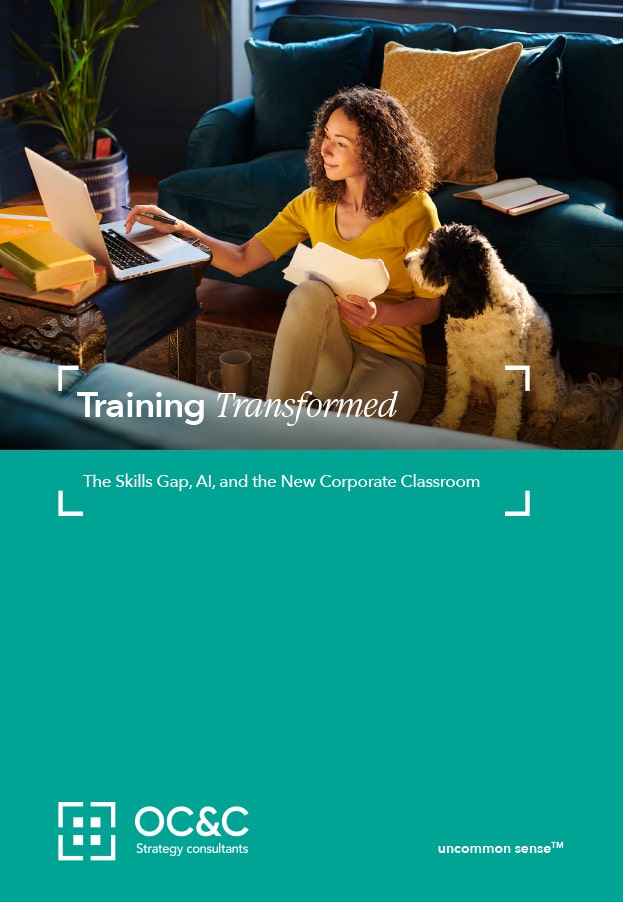Training Transformed – The Skills Gap, AI, and the New Corporate Classroom
To understand the impact and magnitude of the changes taking place in L&D we conducted a survey of 600 senior HR professionals in the US and UK. This includes training buyers in both L&D functions and other business unit-specific functions. This was supplemented by targeted interviews with key industry participants and providers.
Key Insights
The landscape of the Learning and Development (L&D) industry is currently undergoing significant transformation. This change is propelled by a combination of robust market dynamics driven by a burgeoning skills gap, the rapid evolution of artificial intelligence (AI), and shifts in customer expectations, all of which means traditional providers need to adapt.
Sprinting to Keep Up with Moore’s Law
The widening skills gap, especially in digital competencies, poses a critical challenge to corporate sustainability and growth. This gap spans various industries and is expanding with time. Traditionally, companies engaged in a zero-sum battle to attract talent rather than focusing on upskilling. However, change is on the horizon. More executives are now recognising the inherent challenges associated with external hiring, so are increasingly turning towards training and upskilling their current workforce
Redefining the Corporate Learning Environment: The New Corporate Classroom
The long-term secular trends in training delivery have accelerated. Training has transitioned from in-person to virtual (both self-guided and instructor-led) with emphasis on more practical and engaging content (e.g. sandboxes, immediate feedback exercises), and increased sophistication of learning pathways. This acceleration has been driven by multiple factors such as the Covid-19 pandemic which was a pivotal catalyst for migrating to online learning environments, and a growing demand for cost-efficient training solutions without compromising on educational quality.
Several trends are poised to shape the future of corporate training:
- Blended Training Delivery: Purely self-paced models are highly cost-effective but increasingly are not delivering the learning outcomes and behaviour changes required. The shift to self-paced virtual training is stalling and new models combining traditional and digital learning methods are emerging to optimise cost-effectiveness and pedagogical impact. 71% of our respondents believe that blended training is the most effective form of training.
- The AI Paradigm Shift: The rapid progress of AI is set to be game-changing in L&D driving personalised learner journeys, reducing content creation costs and allowing more interactive learning formats. While the L&D buyers surveyed generally agree that AI will lead to material change, many remain reluctant to adopt AI solutions due to concerns around cost and data privacy.
- Emphasis on Return on Investment (ROI): Demonstrating the ROI of training programs is becoming a critical factor for L&D departments and will increasingly influence future procurement decisions. Training is increasingly centrally procured with dedicated teams managing an increasingly large share of spend. The need to demonstrate ROI means shifting away from completion rate as the primary success metric of training towards focusing on the development of new skills that measurably improve performance such as employee productivity or retention.
Evolving to Excel: Competition in L&D
The evolving dynamics within the L&D sector are leading to significant competitive shifts. Two primary business models have emerged:
- Holistic Solutions: Single platforms sold as end-to-end learner journeys, aiming to consolidate a broad range of content across different modalities, integrated with a learning platform playing the role of an LMS/ LXP
- Best-of-breed content providers: These are managed through Learning Experience Platforms (LXP) or Learning Management Systems (LMS), with learner journey design often taking place at the company level, likely driven by an LXP.
Although no clear winner can be defined at this moment, our research suggests a growing preference for platforms that can offer tailored, flexible learning solutions that are easily scalable and capable of integrating new technological advancements efficiently.
Implications for L&D Players
As the L&D industry navigates through these transformative times, the focus is shifting towards more innovative, personalised, and technologically integrated training solutions. For L&D providers the implications are clear:
- It is increasingly critical to understand the specific needs and interests of your customer base, and the subject matter that resonates with them
- Customer expectations will increasingly be that your delivery methods and solutions, align to the learning preferences and requirements of your target segment
- Tracking the effectiveness of L&D programmes and demonstrating ROI will be critical in persuading senior executives to sign off on the investments required to deliver upskill and transform the workforce
For further information on our expertise in navigating the learning and development space, contact our experts today.
Contatos principais
To understand the impact and magnitude of the changes taking place in L&D we conducted a survey of 600 senior HR professionals in the US and UK. This includes training buyers in both L&D functions and other business unit-specific functions. This was supplemented by targeted interviews with key industry participants and providers.
Key Insights
The landscape of the Learning and Development (L&D) industry is currently undergoing significant transformation. This change is propelled by a combination of robust market dynamics driven by a burgeoning skills gap, the rapid evolution of artificial intelligence (AI), and shifts in customer expectations, all of which means traditional providers need to adapt.
Sprinting to Keep Up with Moore’s Law
The widening skills gap, especially in digital competencies, poses a critical challenge to corporate sustainability and growth. This gap spans various industries and is expanding with time. Traditionally, companies engaged in a zero-sum battle to attract talent rather than focusing on upskilling. However, change is on the horizon. More executives are now recognising the inherent challenges associated with external hiring, so are increasingly turning towards training and upskilling their current workforce
Redefining the Corporate Learning Environment: The New Corporate Classroom
The long-term secular trends in training delivery have accelerated. Training has transitioned from in-person to virtual (both self-guided and instructor-led) with emphasis on more practical and engaging content (e.g. sandboxes, immediate feedback exercises), and increased sophistication of learning pathways. This acceleration has been driven by multiple factors such as the Covid-19 pandemic which was a pivotal catalyst for migrating to online learning environments, and a growing demand for cost-efficient training solutions without compromising on educational quality.
Several trends are poised to shape the future of corporate training:
- Blended Training Delivery: Purely self-paced models are highly cost-effective but increasingly are not delivering the learning outcomes and behaviour changes required. The shift to self-paced virtual training is stalling and new models combining traditional and digital learning methods are emerging to optimise cost-effectiveness and pedagogical impact. 71% of our respondents believe that blended training is the most effective form of training.
- The AI Paradigm Shift: The rapid progress of AI is set to be game-changing in L&D driving personalised learner journeys, reducing content creation costs and allowing more interactive learning formats. While the L&D buyers surveyed generally agree that AI will lead to material change, many remain reluctant to adopt AI solutions due to concerns around cost and data privacy.
- Emphasis on Return on Investment (ROI): Demonstrating the ROI of training programs is becoming a critical factor for L&D departments and will increasingly influence future procurement decisions. Training is increasingly centrally procured with dedicated teams managing an increasingly large share of spend. The need to demonstrate ROI means shifting away from completion rate as the primary success metric of training towards focusing on the development of new skills that measurably improve performance such as employee productivity or retention.
Evolving to Excel: Competition in L&D
The evolving dynamics within the L&D sector are leading to significant competitive shifts. Two primary business models have emerged:
- Holistic Solutions: Single platforms sold as end-to-end learner journeys, aiming to consolidate a broad range of content across different modalities, integrated with a learning platform playing the role of an LMS/ LXP
- Best-of-breed content providers: These are managed through Learning Experience Platforms (LXP) or Learning Management Systems (LMS), with learner journey design often taking place at the company level, likely driven by an LXP.
Although no clear winner can be defined at this moment, our research suggests a growing preference for platforms that can offer tailored, flexible learning solutions that are easily scalable and capable of integrating new technological advancements efficiently.
Implications for L&D Players
As the L&D industry navigates through these transformative times, the focus is shifting towards more innovative, personalised, and technologically integrated training solutions. For L&D providers the implications are clear:
- It is increasingly critical to understand the specific needs and interests of your customer base, and the subject matter that resonates with them
- Customer expectations will increasingly be that your delivery methods and solutions, align to the learning preferences and requirements of your target segment
- Tracking the effectiveness of L&D programmes and demonstrating ROI will be critical in persuading senior executives to sign off on the investments required to deliver upskill and transform the workforce
For further information on our expertise in navigating the learning and development space, contact our experts today.







